Precautions on supplemental restraint system
This Supplemental Restraint System (SRS) section contains important information concerning the following systems:
● Driver and passenger supplemental frontimpact
air bag (NISSAN Advanced Air Bag
System)
● Front seat-mounted side-impact supplemental
air bag
● Roof-mounted curtain side-impact supplemental
air bag
● Seat belt with pretensioner
Supplemental front-impact air bag system: The NISSAN Advanced Air Bag System can help cushion the impact force to the head and chest of the driver and front passenger in certain frontal collisions.
Front seat-mounted side-impact supplemental air bag system: This system can help cushion the impact force to the chest and pelvic area of the driver and front passenger in certain side-impact collisions. The side air bags are designed to inflate on the side where the vehicle is impacted.
Roof-mounted curtain side-impact supplemental air bag system: This system can help cushion the impact force to the head of occupants in front and rear outboard seating positions in certain side-impact collisions. The curtain air bags are designed to inflate on the side where the vehicle is impacted.
These supplemental restraint systems are designed to supplement the crash protection provided by the driver and front passenger seat belts and are not a substitute for them. Seat belts should always be correctly worn and the occupant seated a suitable distance away from the steering wheel, instrument panel and door finishers. (See “Seat belts” earlier in this section for instructions and precautions on seat belt usage.) The supplemental air bags operate only when the ignition switch is placed in the ON position.
After placing the ignition switch in the ON position, the supplemental air bag warning light illuminates. The supplemental air bag warning light will turn off after about 7 seconds if the system is operational.
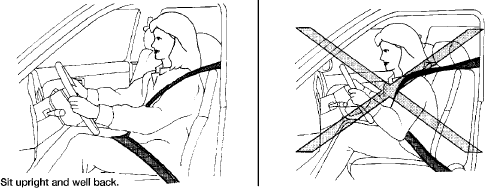
WARNING
● The front air bags ordinarily will not
inflate in the event of a side impact, rear
impact, rollover, or lower severity frontal
collision. Always wear your seat
belts to help reduce the risk or severity
of injury in various kinds of accidents.
● The front passenger air bag will not
inflate if the passenger air bag status
light is lit or if the front passenger seat
is unoccupied. See “Front passenger air
bag and status light” later in this
section.
● The seat belts and the front air bags are
most effective when you are sitting well
back and upright in the seat. The front
air bags inflate with great force. Even
with the NISSAN Advanced Air Bag System,
if you are unrestrained, leaning
forward, sitting sideways or out of position
in any way, you are at greater risk of
injury or death in a crash. You may also
receive serious or fatal injuries from the
front air bag if you are up against it
when it inflates. Always sit back against
the seatback and as far away as practical
from the steering wheel or instrument
panel. Always use the seat belts.
● The driver and front passenger seat belt
buckles are equipped with sensors that
detect if the seat belts are fastened. The
Advanced Air Bag System monitors the
severity of a collision and seat belt usage
then inflates the air bags as
needed. Failure to properly wear seat
belts can increase the risk or severity of
injury in an accident.
● The front passenger seat is equipped
with an occupant classification sensor
(pattern sensor) that turns the front
passenger air bag OFF under some
conditions. This sensor is only used in
this seat. Failure to be properly seated
and wearing the seat belt can increase
the risk or severity of injury in an accident.
See “Front passenger air bag and
status light” later in this section.
● Keep hands on the outside of the steering
wheel. Placing them inside the
steering wheel rim could increase the
risk that they are injured when the front
air bag inflates.
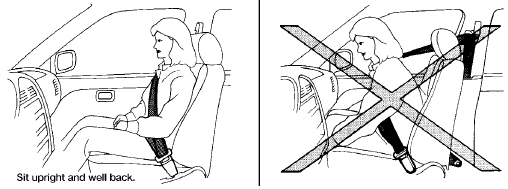
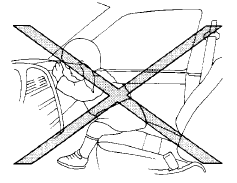
WARNING
● Never let children ride unrestrained or extend their hands or face out of the window. Do not attempt to hold them in your lap or arms. Some examples of dangerous riding positions are shown in the illustrations.
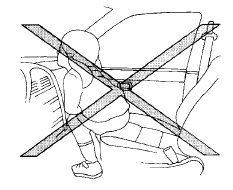
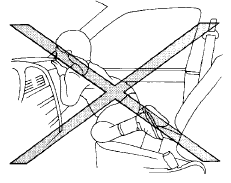
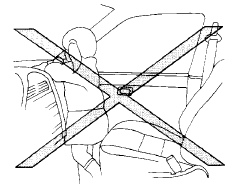
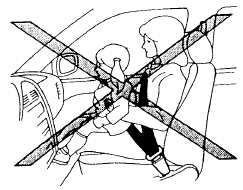
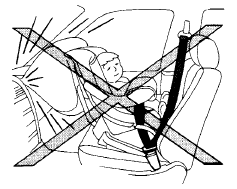
WARNING
● Children may be severely injured or killed when the front air bags, side air bags or curtain air bags inflate if they are not properly restrained. Pre-teens and children should be properly restrained in the rear seat, if possible.
● Even with the NISSAN Advanced Air Bag System, never install a rear-facing child restraint in the front seat. An inflating front air bag could seriously injure or kill your child. See “Child restraints” earlier in this section for details.
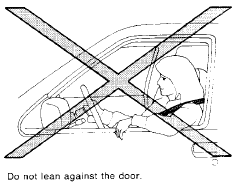
WARNING
Front seat-mounted side-impact supplemental air bags and roof-mounted curtain side-impact supplemental air bags:
● The side air bags and curtain air bags ordinarily will not inflate in the event of a frontal impact, rear impact, rollover or lower severity side collision. Always wear your seat belts to help reduce the risk or severity of injury in various kinds of accidents.
● The seat belts, the side air bags and curtain air bags are most effective when you are sitting well back and upright in the seat with both feet on the floor. The side air bag and curtain air bag inflate with great force. Do not allow anyone to place their hand, leg or face near the side air bag on the side of the seatback of the front seat or near the side roof rails. Do not allow anyone sitting in the front seats or rear outboard seats to extend their hand out of the window or lean against the door. Some examples of dangerous riding positions are shown in the previous illustrations.
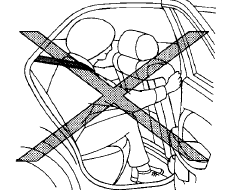
WARNING
● When sitting in the rear seat, do not hold onto the seatback of the front seat. If the side air bag inflates, you may be seriously injured. Be especially careful with children, who should always be properly restrained. Some examples of dangerous riding positions are shown in the illustrations.
● Do not use seat covers on the front seatbacks. They may interfere with side air bag inflation.
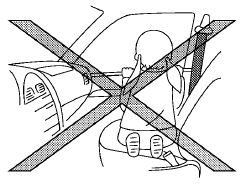
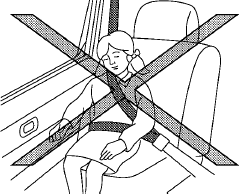
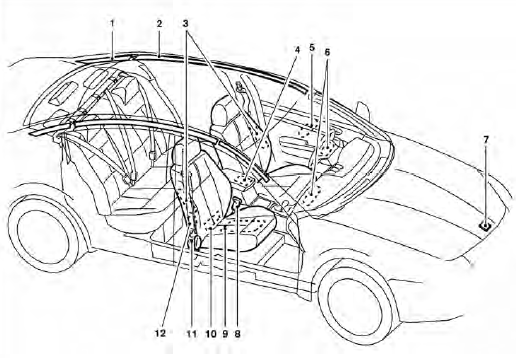
Coupe
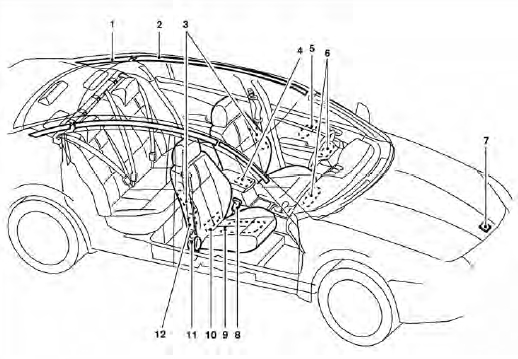
Sedan
1. Roof-mounted curtain side-impact
supplemental air bag inflators
2. Roof-mounted curtain side-impact
supplemental air bags
3. Front seat-mounted side-impact
supplemental air bag modules
4. Air bag Control Unit (ACU)
5. Side-impact pressure sensor (driver’s
side shown; passenger’s side similar)
6. Supplemental front-impact air bag
modules
7. Crash zone sensor
8. Seat belt buckle switches on driver’s
and passenger’s side
9. Occupant classification sensor
(pattern sensor)
10. Occupant classification system control
unit
11. Seat belt with pretensioner
12. Side satellite sensor
See also:
Automatic operation (AUTO)
The AUTO mode may be used all year around as
the system automatically controls constant
temperature, air flow distribution and fan speed.
To turn off the heater and air conditioner, turn the
fa ...
Never leave these keys in the vehicle.
As many as 4 Intelligent Keys can be registered
and used with one vehicle. The new keys must be
registered by a NISSAN dealer prior to use with
the Intelligent Key and NISSAN Vehicle Immobilizer ...
Read first — then drive safely
Before driving your vehicle, read your Owner’s
Manual carefully. This will ensure familiarity with
controls and maintenance requirements, assisting
you in the safe operation of your vehicle.
...
